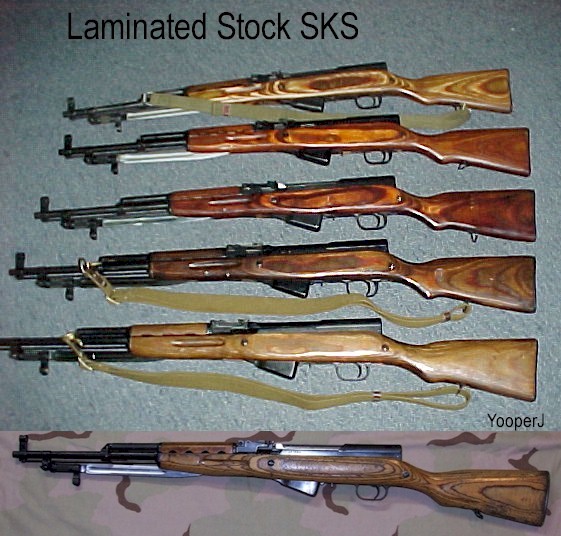
SECTION 18: In this section I will try to show the differences between
the same part from different arsenals, years and countries. The only purpose of
this page is to help make the collector aware that differences do occur and
about anything could be possible. These are ALL from my personal observations
and not from any books.
The various pictures below show the STOCKS & HAND GUARDS from various makes
and models of SKS's. All stocks except for the jungle stock were stamped
with the rifles serial number. All models were stamped on the left butt
stock. The Russian SKS had the complete serial number and on solid stocks had
the makers cartouche and year included. Laminated stocks only had the
serial number. Sino-Soviet models also had the complete serial number
along with acceptance stampings next to the side mounted sling swivel. Currently these are the only differences I have noticed.
Some are only cosmetic, some have different stampings, some are shaped slightly
different and some are just plain different. NOTE:
On some I have no idea as to what type of wood it is. This is just from
my observation and may or may not be original to the gun!

This picture shows some of the variation in the Laminated Stocks used on the SKS rifle. The material used in making these stocks was what is referred to as Artic Birch or Russian Birch. The top one is a Chinese with a black bolt that was sent to Egypt at some point in time. This stock had the Egyptian painted letters on the right side. All others are Russian except for the bottom one which is Polish. Notice the 2 cross bolts or lugs, one below the rear sight and the other at the wrist. Only Laminated stocks have the 2 bolts.
![]()
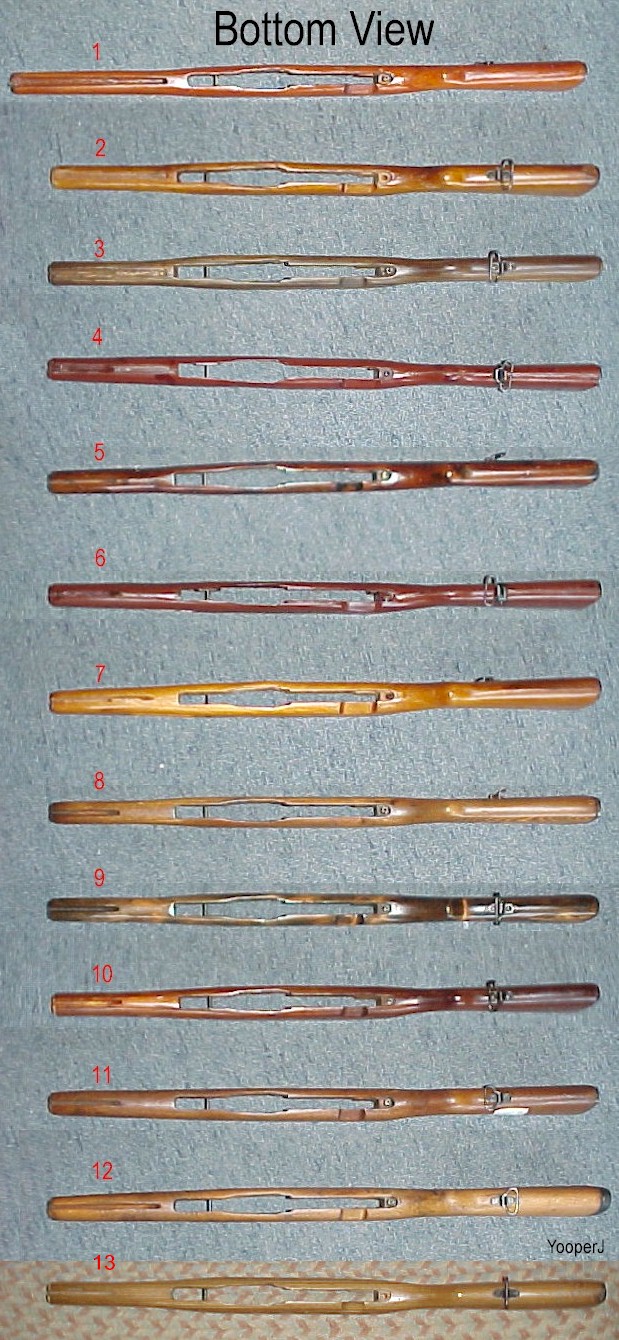
1. Albania spike
2. China spike
3. China/Egypt spike
4. China Jungle spike
5. Sino-Soviet Letter Gun blade
6. China Jungle blade
7. China Paratrooper blade
8. North Korea blade
9. Russia Hardwood
10. Russia Laminated
11. Yugoslavia M59 blade
12. Yugoslavia M59/66 blade
13. Poland
The Albanian SKS has the longest stock of all the variations of the SKS.
The Polish has a thicker wrist area.
The Yugoslavian 59/66 is slightly longer because of the rubber butt pad added for the launching of grenades.
Chinese, North Korean, North Vietnamese, Polish, Romanian, Russian and Yugoslavian all have the same basic dimensions, I refer to these as a Standard SKS.
![]()
Butt Stock Markings
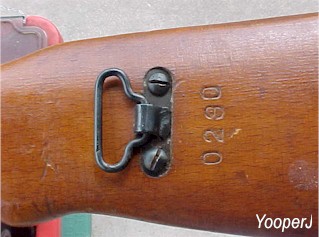
This is an Albanian that is marked with full serial number. Albanian stocks appear to be made out of Beech wood.
![]()
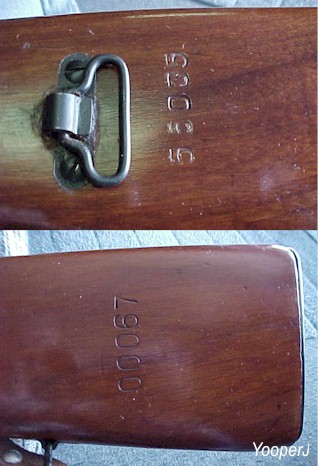
China used both the side and bottom mounted sling swivels. China also only included the last five digits when marking the stocks. All military stocks that were original to the gun were stamped this way. China used a wood referred to as Chu wood. Proper name is Catalpa wood.
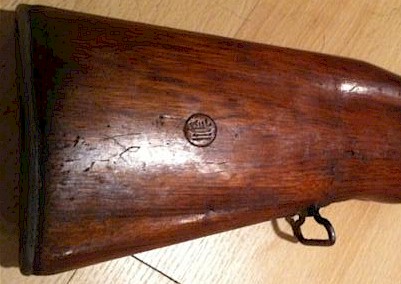
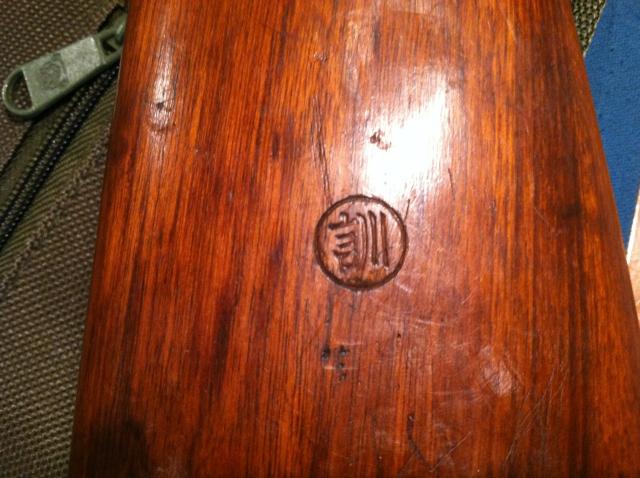
This is a marking found on the right side of the butt stock. Not sure if it is a unit marking or some sort of proof.
Quite possible it was done by an individual, not sure and any help is appreciated.
![]()
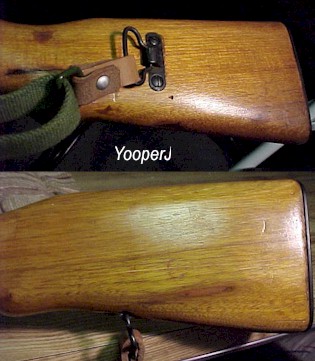
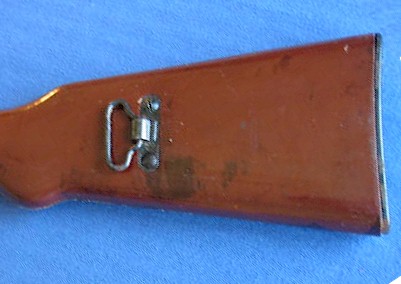
China used replacement stocks with either design of sling swivels. All unmarked stocks are believed to be a replacement for a previously damaged stock.
The plastic resin stock on the right is often referred to as a Jungle Stock. It is believed to be a replacement for rotted wooden stocks that were subjected to the harsh tropical conditions and often times buried in sand. No real documentation of this but they were seen in Viet Nam. No s/n stampings are found. The swivel is found both on the side and bottom
![]()
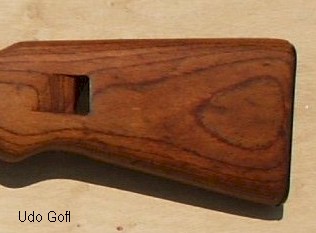
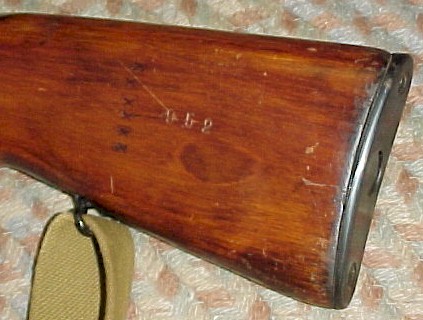
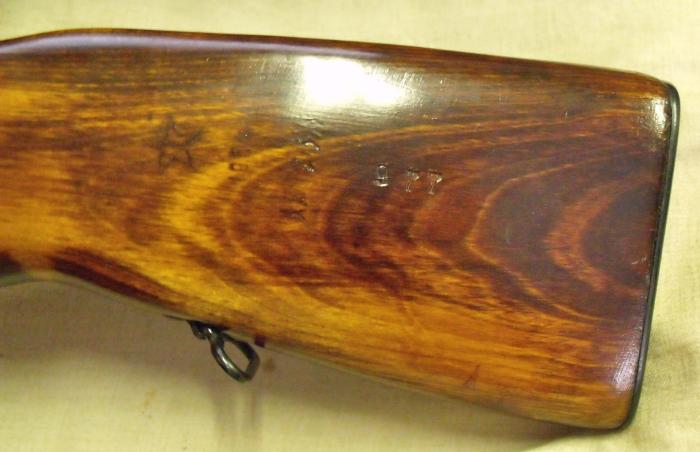
East German stocks were unmarked, laminated and made from what appears to be Birch wood.
The Russian made and DDR marked SKS had the last 3 digits of the s/n stamped horizontally on the butt stock. (right)
![]()
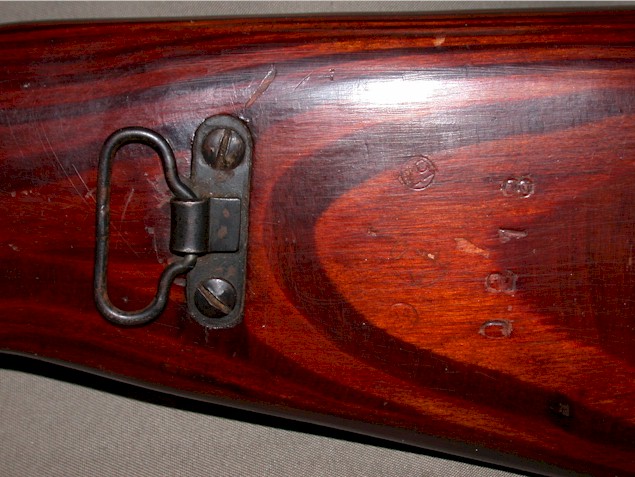
North Korea marked the full serial number. Korean stocks were all Laminated stocks. These also appear to be made from Birch.
![]()
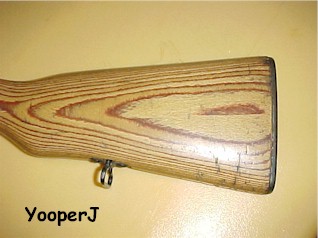
Polish stocks were unmarked, laminated and made from what appears to be Birch wood with a light colored finish.
![]()
Romania used a solid wood and used the full serial number minus the year. Romania used Beech wood.
![]()
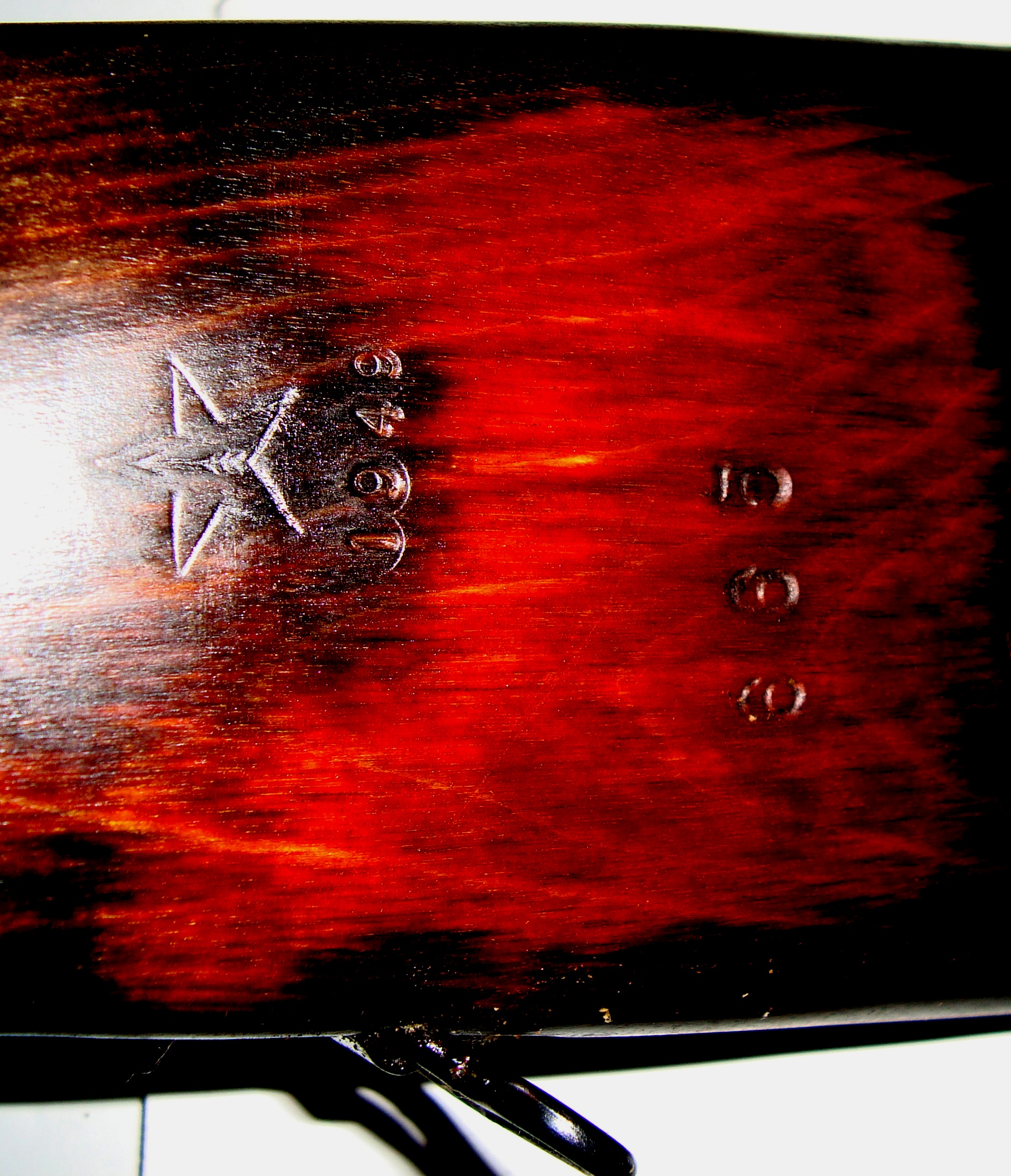
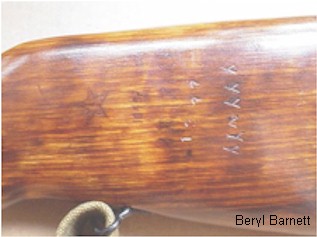
This is a stock from a 1949 Russian SKS that has gone through the refurb process several times. Note the Tula star and below it the year of 1949. This stock fits the Russian spike bayonet.
![]()

A - Russian 1954 Izhevsk Arsenal - Matching stock to receiver - full serial number - factory cartouche and year of manufacturer. One piece Artic Birch Stock.
B - Russian 1955 Tula Arsenal - Matching stock to receiver - full serial number - factory cartouche and year of manufacturer. One piece Artic Birch Stock.
C - Russian Tula Arsenal - Matching stock to receiver - full serial number - Laminated Birch stock.
![]()
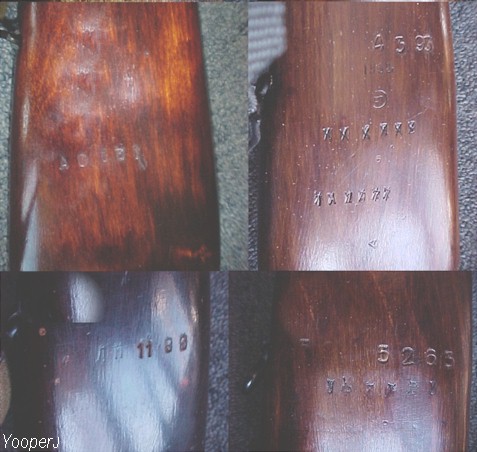
Examples of stocks used during the rebuild process and either stamped with new serial number or old numbers XXXXXX'd out and new numbers applied. All are Russian hardwood stocks.
![]()
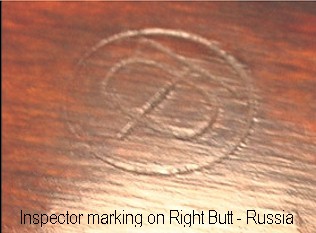
This is an Inspector marking found on the right side of the butt stock on Russian SKS's.
This one is from an all matching Tula arsenal gun.
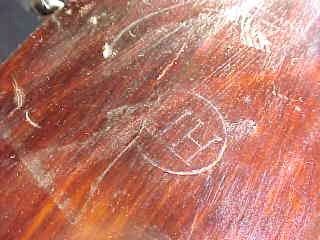
This is an Inspector marking found on the right side of the butt stock on Russian SKS's.
This one is from an all matching Izhevsk arsenal gun.
![]()
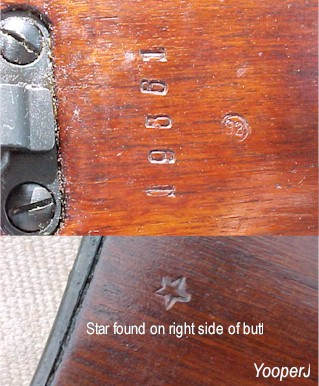
Sino-Soviet SKS's are early Chinese with Russian looks that show full serial number and inspector cartouche on the left side. Letter Guns have a side sling swivel others up to 1960 had a bottom sling swivel. These stocks appear to be made out of the same material as the Russian stocks, Artic Birch. Letter Gun Sino Soviets had a star stamped into the right side of the butt stock.
![]()
Yugoslavian M59 used a one piece hardwood sock with the serial number without the letter prefix stamped into the stock. Some believe some of these stocks are Teak but that wood is not native to Yugoslavia. It is believed that the wood used for some of these is Carpathian Elm. When it is quarter sawn it resembles Teak. Some were made from Beech and can be plain or grainy. The way the Beech was cut, it produced a very grainy look on some stocks.
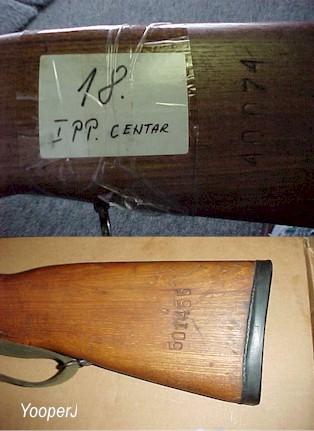
Yugoslavian M59-66 is stamped in similar fashion and uses the same type of wood. The way the Beech was cut produced a very grainy look. Also some were made from the Carpathian Elm.
![]()
Details
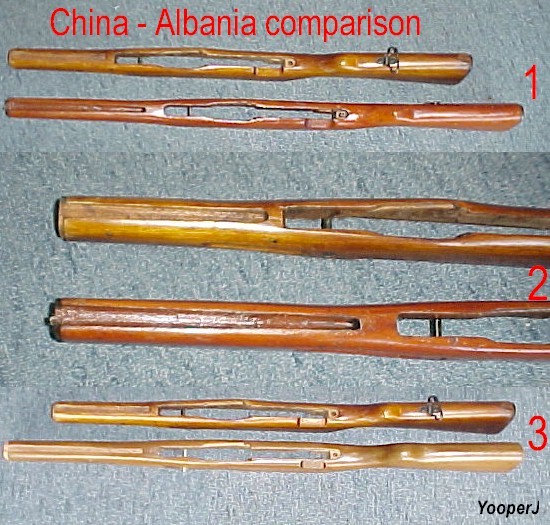
If you look at the above pictures it is clear to see that the Albanian stock is much longer than its Chinese counterpart. But, look closely to see where the "true" added length is. It is at the very front of the stock. The length of pull (from the trigger to the butt plate) is nearly the same on all the variations of the SKS except for the Yugoslavian M59/66. This model has a additional rubber pad mounted on the butt to absorb grenade launching recoil.
![]()

ALBANIA
Dimension A) overall length with butt plate is 32 1/2"
Dimension B) from center of front recoil lug to trigger assembly spring is 9 3/8"
Dimension C) from end of front cut out to trigger assembly spring is 10 7/8"
![]()
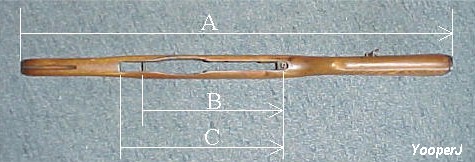
Standard SKS stock
Dimension A) overall length with butt plate is 29 1/4"
Dimension B) from center of front recoil lug to trigger assembly spring is 9 1/2"
Dimension C) from end of front cut out to trigger assembly spring is 11"
![]()
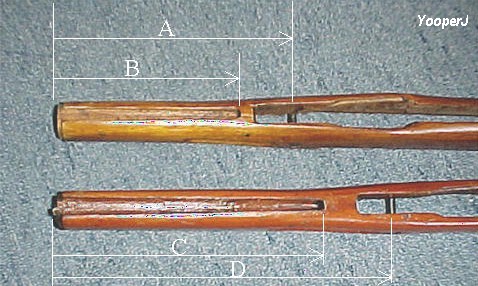
Comparison of Chinese (top) and Albanian (bottom)
Dimension A) from front of stock to center of recoil lug is 8 5/16"
Dimension B) from front of stock to end of bayonet cut out is 6 1/4"
Dimension C) from front of stock to end of bayonet cut out is 9"
Dimension D) from front of stock to center of recoil lug is 11 1/2"
![]()
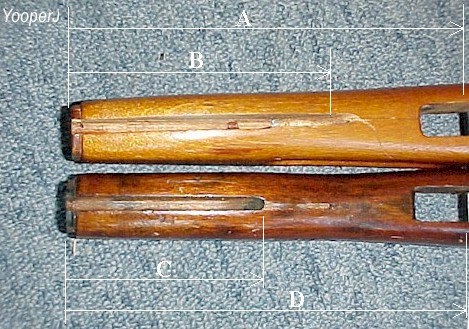
Comparison of Chinese Paratrooper (top) and Standard SKS (bottom)
Dimension A) from front of stock to center of recoil lug is 8 5/16"
Dimension B) from front of stock to end of bayonet cut out is 5 1/2"
Dimension C) from front of stock to end of bayonet cut out is 3 3/4"
Dimension D) from front of stock to center of recoil lug is 8 5/16"
The stock cross bolt is installed with the flat sides up and to the rear of the stock.
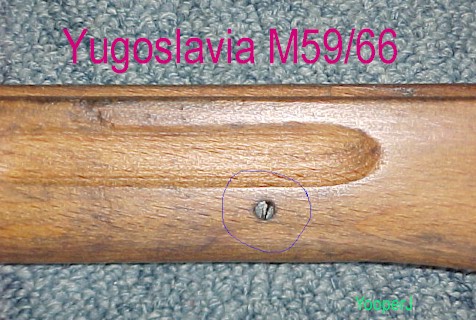
Yugoslavian M59/66 - Note the bolt that goes through the stock to add strength for the grenade launcher.
![]()
 HAND GUARDS
HAND GUARDS

The Hand Guard was used to guard the hand from the heat of the gas going though the gas system housed below the hand guard. All of them served the dame purpose but they varied by country and also by the material used. I'll show some of the more common ones associated with their country of origin.
Albania used a longer than usual hand guard and slots for cooling.
![]()
China
![]()
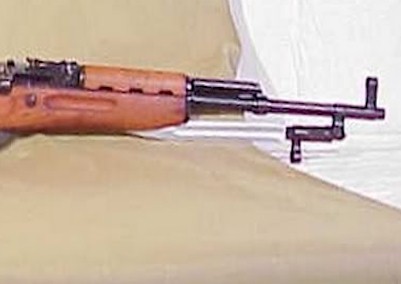
East German was a typical hand guard while the Russian marked DDR gun stamped the last 3 digits of s/n horizontally.
![]()
North Korea
![]()
Poland
![]()
Russia
![]()
Yugoslavia

This page is still under Construction!!
YooperJ
Started in
1999 by [Yooper John's]. All rights reserved.
Revised:
04 Mar 2016 12:54:28 -0600
.